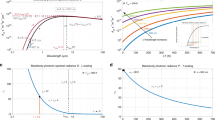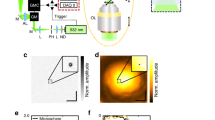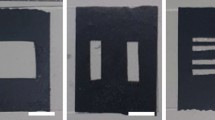Abstract
All limitations commonly associated with imaging, such as resolution, field of view and depth of field, arise from linear theory1. Nonlinear optics can break these limits by exploiting the presence and interaction of many photons at once. To date, nearly all nonlinear imaging techniques have relied on point processes, such as two-photon fluorescence2 or harmonic effects3, in which the temporal frequency is the relevant parameter. These methods ignore the spatial content of the object, typically require scanning to record a whole image, and remain restricted by linear propagation from the sample to the detector. Spatial nonlinearity can overcome these issues by mixing modes with high and low spatial frequencies. Here, we generalize Abbe's theory of diffraction1 to include nonlinear propagation and show that wave mixing can be treated as a self-induced structured illumination. We demonstrate this experimentally by nonlinearly enhancing a standard imaging system beyond its conventional limits.
This is a preview of subscription content, access via your institution
Access options
Subscribe to this journal
Receive 12 print issues and online access
$209.00 per year
only $17.42 per issue
Buy this article
- Purchase on Springer Link
- Instant access to full article PDF
Prices may be subject to local taxes which are calculated during checkout





Similar content being viewed by others
References
Abbe, E. Beiträge zur Theorie des Mikroskops und der micrkoskopischen Wahrnehmung. Arch. Mikrosk. Anat. 9, 413–468 (1873).
Denk, W., Strickler, J. H. & Webb, W. W. Two-photon laser scanning fluorescence microscopy. Science 248, 73–76 (1990).
Campagnola, P. J., Clark, H. A., Mohler, W. A., Loew, L. M. & Lewis, A. Second-harmonic imaging microscopy of living cells. J. Biomed. Opt. 6, 277–286 (2001).
Heintzmann, R. & Cremer, C. Laterally modulated excitation microscopy: improvement of resolution by using a diffraction grating. Proc. SPIE 3568, 185–196 (1999).
Di Francia, T. Resolving power and information. J. Opt. Soc. Am. 45, 497–501 (1955).
Gorodnitsky, I. F. & Rao, B. D. Sparse signal reconstruction from limited data using FOCUSS: a re-weighted minimum norm algorithm. IEEE Trans. Sign. Proc. 45, 600–616 (1997).
Ash, E. A. & Nicholls, G. Super-resolution aperture scanning microscope. Nature 237, 510–512 (1972).
Carrington, W. A. et al. Superresolution three-dimensional images of fluorescence in cells with minimal light exposure. Science 268, 1483–1487 (1995).
Pavani, S. R. P. et al. Three-dimensional, single-molecule fluorescence imaging beyond the diffraction limit by using a double-helix point spread function. Proc. Natl Acad. Sci. USA 106, 2995–2999 (2009).
Gustafsson, M. G. L. Surpassing the lateral resolution limit by a factor of two using structured illumination microscopy. J. Microsc. 198, 82–87 (2000).
Klar, T. A. & Hell, S. W. Subdiffraction resolution in far-field fluorescence microscopy. Opt. Lett. 24, 954–956 (1999).
Rust, M. J., Bates, M. & Zuang, X. Sub-diffraction-limit imaging by stochastic optical reconstruction microcopy (STORM). Nat. Methods 3, 793–795 (2006).
Betzig, E. et al. Imaging intracellular fluorescent proteins at nanometer resolution. Science 313, 1642–1645 (2006).
Fischer, B., Cronin-Golomb, M., White, J. O. & Yariv, A. Real-time phase conjugate window for one-way optical field imaging through a distortion. Appl. Phys. Lett. 41, 141–143 (1982).
Kip, D., Anastassiou, C., Eugenieva, E., Christodoulides, D. & Segev, M. Transmission of images through highly nonlinear media by gradient-index lenses formed by incoherent solitons. Opt. Lett. 26, 524–526 (2001).
Yang, J., Zhang, P., Yoshihara, M., Hu, Y & Chen, Z. Image transmission using stable solitons of arbitrary shapes in photonic lattices. Opt. Lett. 36, 772–774 (2011).
Hong, J. H., Chiou, A. E. & Yeh, P. Image amplification by two-wave mixing in photorefractive crystals. Appl. Opt. 29, 3026–3029 (1990).
Dylov, D. V. & Fleischer, J. W. Nonlinear self-filtering of noisy images via dynamical stochastic resonance. Nature Photon. 4, 323–328 (2010).
Barsi, C., Wan, W. & Fleischer, J. W. Imaging through nonlinear media using digital holography. Nature Photon. 3, 211–215 (2009).
Lukosz, W. & Marchand, M. Optischen Abbildung unter Überschreitung der Beugungsbedingten Auflösungsgrenze. Opt. Acta 10, 241–245 (1963).
Gustafsson, M. G. L. Nonlinear structured-illumination microscopy: wide-field fluorescence imaging with theoretically unlimited resolution. Proc. Natl Acad. Sci. USA 102, 13081–13086 (2005).
Wan, W., Jia, S. & Fleischer, J. W. Dispersive, superfluid-like shock waves in nonlinear optics. Nature Phys. 3, 46–51 (2007).
Tsang, M., Psaltis, D. & Omenetto, F. G. Reverse propagation of femtosecond pulses in optical fibers. Opt. Lett. 28, 1873–1875 (2003).
Feit, M. D. & Fleck, J. A. Jr. Beam nonparaxiality, filament formation, and beam breakup in the self-focusing of optical beams. J. Opt. Soc. Am. B 5, 633–640 (1988).
Greenspan, H., Anderson, C. H. & Akber, S. Image enhancement by nonlinear extrapolation in frequency space. IEEE Trans. Image Proc. 9, 1035–1048 (2000).
Renger, J., Quidant, R., van Hulst, N. & Novotny, L. Surface-enhanced nonlinear four-wave mixing. Phys. Rev. Lett. 104, 046803 (2010).
Emile, O., Galstyan, T., Le Floch, A. & Bretenaker, F. Measurement of the nonlinear Goos–Hänchen effect for Gaussian optical beams. Phys. Rev. Lett. 75, 1511–1513 (1995).
Sun, C. et al. Observation of the kinetic condensation of classical waves. Nature Phys. 8, 470–474 (2012).
Lu, C-H. et al. Phase retrieval using nonlinear diversity. Appl. Opt. 52, D92 (2013).
DelRe, E., Spinozzi, E., Agranat, A. J. & Conti, C. Scale-free optics and diffractionless waves in nanodisordered ferroelectrics. Nature Photon. 5, 39–42 (2011).
Acknowledgements
This work was supported by the US Air Force Office of Scientific Research. The authors thank N. Pégard for valuable discussions.
Author information
Authors and Affiliations
Contributions
C.B. and J.W.F. conceived and designed the experiments. C.B. performed the experiments and simulations. Both authors analysed the data and wrote the manuscript.
Corresponding author
Ethics declarations
Competing interests
C. Barsi and J. W. Fleischer are named inventors on US patent 8,427,650 (issued 23 April 2013), which is related to techniques described in this Letter.
Supplementary information
Supplementary information
Supplementary information (PDF 1406 kb)
Rights and permissions
About this article
Cite this article
Barsi, C., Fleischer, J. Nonlinear Abbe theory. Nature Photon 7, 639–643 (2013). https://doi.org/10.1038/nphoton.2013.171
Received:
Accepted:
Published:
Issue Date:
DOI: https://doi.org/10.1038/nphoton.2013.171
This article is cited by
-
Nonlinear Imaging using Object-Dependent Illumination
Scientific Reports (2019)
-
Propagation phasor approach for holographic image reconstruction
Scientific Reports (2016)
-
Defying Abbe's law
Nature Photonics (2013)



